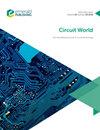基于解析模型的Ge-Si异质结构TFET电路性能分析
IF 0.7
4区 工程技术
Q4 ENGINEERING, ELECTRICAL & ELECTRONIC
引用次数: 2
摘要
目的在当前VLSI时代,高封装密度造成了严重的功率危机,限制了MOSFET器件作为CMOS技术组成块的使用。这导致研究人员寻找替代器件,可以取代CMOS VLSI逻辑设计中的MOSFET。在对替代器件的探索中,隧道场效应晶体管作为一种潜在的替代器件在最近出现了。本研究的目的是提高所提出的器件结构的性能,并使其与电路实现兼容。最后,将该电路的性能与CMOS电路进行了比较,对比研究了该电路相对于传统CMOS电路的优越性。设计/方法/途径硅锗异质结构是目前隧道场效应晶体管等半导体器件中最有前途的结构之一。利用MATLAB软件对分析模型进行了计算和编程。利用Silvaco TCAD (ATLAS)软件对器件进行二维仿真。通过ATLAS仿真数据验证了模型的正确性。因此,利用所提出的器件实现了逆变电路。利用Tanner EDA工具对电路进行了仿真,以评估其性能。与同类异质结构相比,所提出的优化器件几何结构具有非常低的OFF电流(数量级为10^−18 A/um),相当高的ON电流(5x10^−5 A/um)和陡峭的亚阈值斜率(20 mV/decade),随后具有优异的ON - OFF电流比(数量级为10^13)。该器件具有非常低的阈值电压,甚至小于0.1 V,是类cmos数字电路中MOSFET的良好替代品。因此,该器件被用于构建一个电阻式逆变器来研究电路的性能。将电阻式逆变电路与电阻式CMOS逆变电路进行了比较。从功耗、传播延迟和功率延迟积等方面对两种电路的性能进行了分析和比较。实验结果证明,基于异质结隧道场效应管(HTFET)的逆变器的性能矩阵远远领先于基于cmos的逆变器。本文从性能矩阵的角度对叠栅氧化锗硅HTFET进行了分析建模和优化。与当代文献中发表的器件结构相比,该器件的性能是相当可观的。采用该器件实现的类CMOS电阻式逆变电路在45nm工艺节点上的性能优于传统CMOS电路。本文章由计算机程序翻译,如有差异,请以英文原文为准。
Analysis of circuit performance of Ge-Si hetero structure TFET based on analytical model
Purpose
High packaging density in the present VLSI era builds an acute power crisis, which limits the use of MOSFET device as a constituent block in CMOS technology. This leads researchers in looking for alternative devices, which can replace the MOSFET in CMOS VLSI logic design. In a quest for alternative devices, tunnel field effect transistor emerged as a potential alternative in recent times. The purpose of this study is to enhance the performances of the proposed device structure and make it compatible with circuit implementation. Finally, the performances of that circuit are compared with CMOS circuit and a comparative study is made to find the superiority of the proposed circuit with respect to conventional CMOS circuit.
Design/methodology/approach
Silicon–germanium heterostructure is currently one of the most promising architectures for semiconductor devices such as tunnel field effect transistor. Analytical modeling is computed and programmed with MATLAB software. Two-dimensional device simulation is performed by using Silvaco TCAD (ATLAS). The modeled results are validated through the ATLAS simulation data. Therefore, an inverter circuit is implemented with the proposed device. The circuit is simulated with the Tanner EDA tool to evaluate its performances.
Findings
The proposed optimized device geometry delivers exceptionally low OFF current (order of 10^−18 A/um), fairly high ON current (5x10^−5 A/um) and a steep subthreshold slope (20 mV/decade) followed by excellent ON–OFF current ratio (order of 10^13) compared to the similar kind of heterostructures. With a very low threshold voltage, even lesser than 0.1 V, the proposed device emerged as a good replacement of MOSFET in CMOS-like digital circuits. Hence, the device is implemented to construct a resistive inverter to study the circuit performances. The resistive inverter circuit is compared with a resistive CMOS inverter circuit. Both the circuit performances are analyzed and compared in terms of power dissipation, propagation delay and power-delay product. The outcomes of the experiments prove that the performance matrices of heterojunction Tunnel FET (HTFET)-based inverter are way ahead of that of CMOS-based inverter.
Originality/value
Germanium–silicon HTFET with stack gate oxide is analytically modeled and optimized in terms of performance matrices. The device performances are appreciable in comparison with the device structures published in contemporary literature. CMOS-like resistive inverter circuit, implemented with this proposed device, performs well and outruns the circuit performances of the conventional CMOS circuit at 45-nm technological node.
求助全文
通过发布文献求助,成功后即可免费获取论文全文。
去求助
来源期刊

Circuit World
工程技术-材料科学:综合
CiteScore
2.60
自引率
0.00%
发文量
33
审稿时长
>12 weeks
期刊介绍:
Circuit World is a platform for state of the art, technical papers and editorials in the areas of electronics circuit, component, assembly, and product design, manufacture, test, and use, including quality, reliability and safety. The journal comprises the multidisciplinary study of the various theories, methodologies, technologies, processes and applications relating to todays and future electronics. Circuit World provides a comprehensive and authoritative information source for research, application and current awareness purposes.
Circuit World covers a broad range of topics, including:
• Circuit theory, design methodology, analysis and simulation
• Digital, analog, microwave and optoelectronic integrated circuits
• Semiconductors, passives, connectors and sensors
• Electronic packaging of components, assemblies and products
• PCB design technologies and processes (controlled impedance, high-speed PCBs, laminates and lamination, laser processes and drilling, moulded interconnect devices, multilayer boards, optical PCBs, single- and double-sided boards, soldering and solderable finishes)
• Design for X (including manufacturability, quality, reliability, maintainability, sustainment, safety, reuse, disposal)
• Internet of Things (IoT).
 求助内容:
求助内容: 应助结果提醒方式:
应助结果提醒方式:


